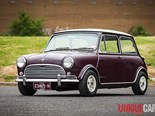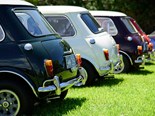Twin-Engined 1970 Mini - Reader Resto














.jpg)
.jpg)

































|

|

|

|

|

|

|
.jpg)
|

|

|

|

|

|

|

|

|

|

|

|

|

|

|

|

|
Sometimes one engine just isn't enough. Reader Chris Britten unleashes his weird brand of genius on BMC's icon
Twin-Engined 1970 Mini
The first thing anybody asks me when they see this thing is: Why? The truth is, I’ve been thinking about building a twin-engined Mini since 1966. Back then I had a brand-new Cooper S and I started reading about Minis generally. That led me to stumble across a twin-engined version that BMC had built in England. But I reckon mine’s a far more sophisticated job than theirs.
It all started about four or five years ago when I began restoring a Mini I’d actually been given, because it was a bit of a mess. It was my first Mini after that Cooper S back in 1966, so I’d had plenty of time to think about things. Anyway, I started cutting the rusty floors out of it and I just suddenly thought: ‘Bugger it; I’ll build it as a Twini.’ Little did I know… In fact, about the first year of the build was spent sitting on a stool and looking at it, trying to figure out how it was all going to work.
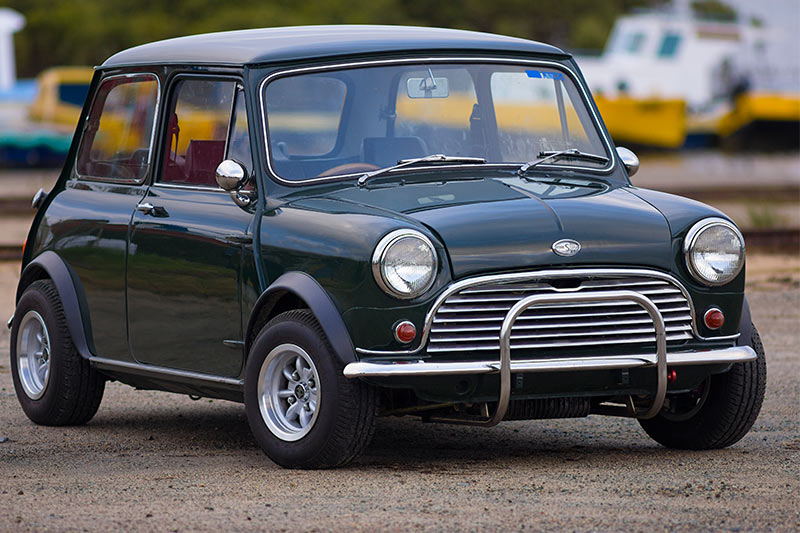 Like all the best sleepers, you probably wouldn't guess just by looking at it
Like all the best sleepers, you probably wouldn't guess just by looking at it
I reckon mine is unique (Even though twin-engined Minis are a bit thin on the ground generally. Ed.) because of its layout. Every other twin-engined Mini I’ve ever heard of has had the second engine where the back seat normally goes. That means you still have a boot (sort of) but apparently, a Twini done the traditional way (Eh?) is fumy and smelly when it’s running and hideously noisy to drive. So I wanted to put the second motor in the boot. That way, I’d still have a rear seat and the car would look standard… I like sleepers.
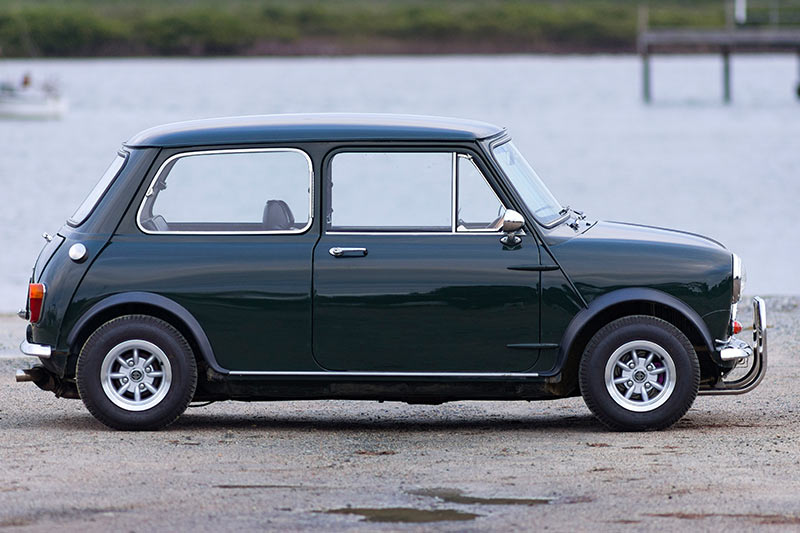
But having the second engine in the boot threw up all sorts of engineering problems. I started out with a front sub-frame to carry the engine, but when you work out where the driveshafts need to sit relative to the wheels and everything else, you soon realise that the engine has to be turned around and mounted backwards. That’s not a problem until you think about which way a Mini engine runs. My plan was looking like giving me four reverse gears in the rear engine and only one forward ratio. Would have been a little green tug-of-war.

The solution there is to make the rear engine physically run backwards. And there’s a whole new can of worms. The biggest problem was that when you spin the motor backwards, the con-rods suddenly – because of the different timing – clobber the camshaft lobes (the camshaft also has to be reground as a mirror image of the standard one). The fix was to find a set of con-rods with a thinner section. Cheap and it worked. But I also had to reverse the oil-pump plumbing, cobble up an electric water pump with a reversed impeller and the ignition is crank-trigger. To get the engine to physically fit, I had to push the rear firewall and rear seat forward a few millimetres; not much, and then everything more or less dropped into place.
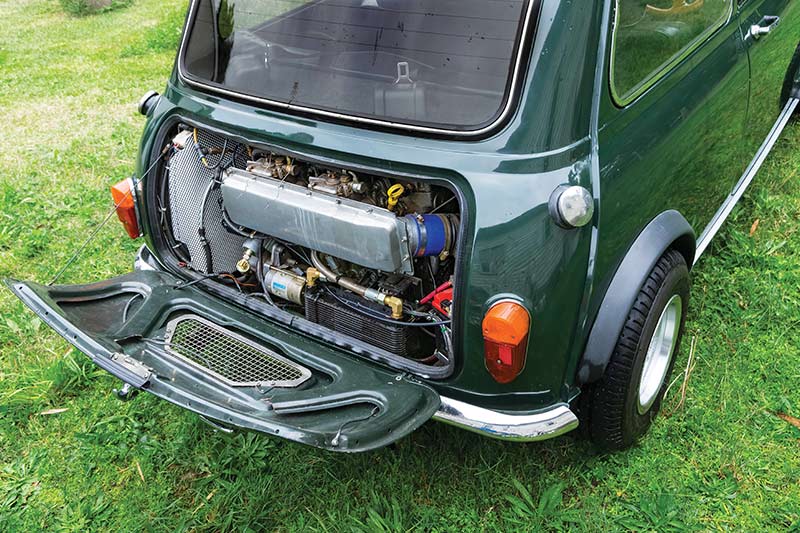
There’s a radiator for each engine, but they’re both mounted up front on either side of the engine bay. The plumbing for the rear engine’s radiator runs up each sill. Probably the biggest hassle was synchronising the two gearshifts. I scratched my head for a long time over that one – eventually I got a second shifter block, milled off the pivot where the gearstick sits, and plonked the second one, upside-down on top of the first. Everybody said: Nah, that’s too simple, it’ll never work. But it does. There’s also a pin in the rear selector rod that I can remove that leaves the rear gearbox in neutral so I can drive on just the front engine if I ever need to. The clutch works via a pair of standard clutch master cylinders that I siamesed and mounted with two actuating rods coming off the clutch pedal. The clutches are heavy-duty, too, and being two of them, the pedal effort is pretty high. I thought about boosting the clutch, but I’ve managed instead to just get used to it.
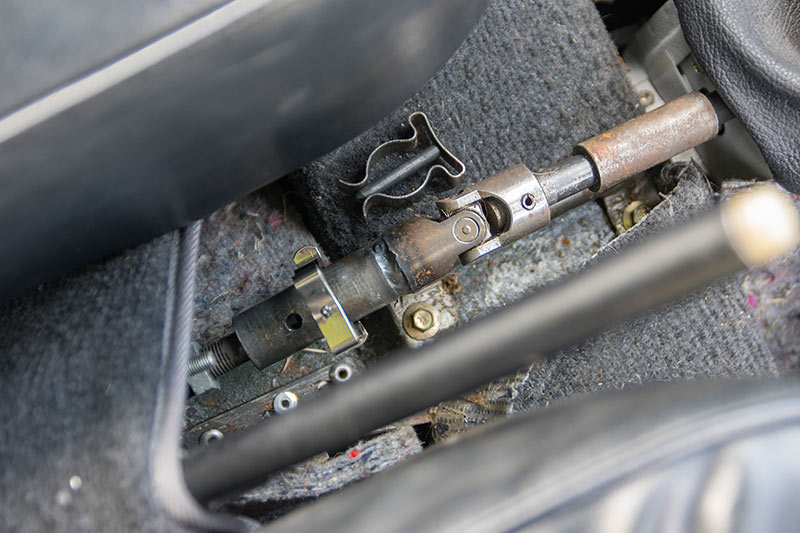 Gearshift linkage looks like one of those things that should never, ever work
Gearshift linkage looks like one of those things that should never, ever work
The suspension is Hydrolastic, and I kept it for some strange reason. Probably the same reason I built the damn thing in the first place. The front engine is a 1330cc Cooper S spec, the rear is on its first overbore, so it’s only 1293cc. The front uses a single 45mm Weber and the rear has a pair of 40mm sidedrafts. On the dyno, the front made just under 100 horsepower and the rear was just over 100. It likes a drink. I reckon I use about 12 or 14 litres per 100km which isn’t great, but I’m not fussed. It’s a 16-valve, twin-cam, four-wheel-drive Mini and that’ll do me. I wish I’d had it in 1966.
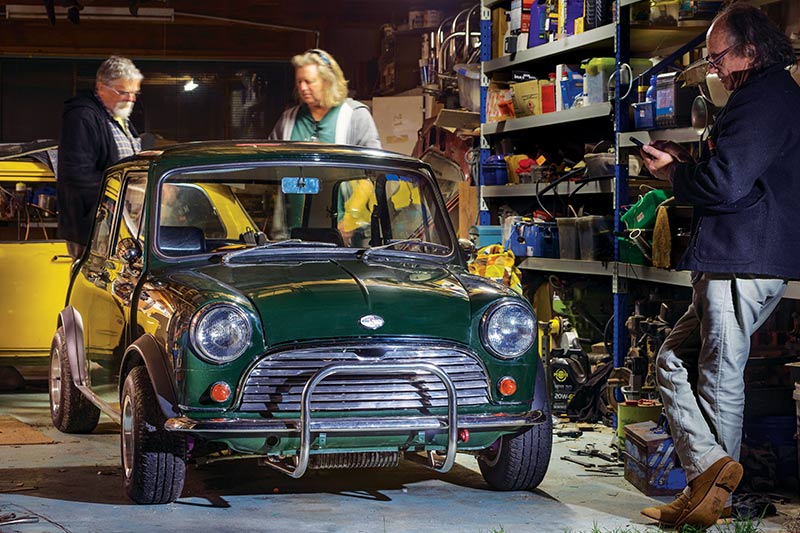
MORLEY TRIES IT OUT
I’ve always been fascinated by home-brewed specials. And twin-engined cars. And, yes, even Minis. So when the opportunity came to take a look at Chris’ car, I didn’t need to be asked twice. And when he offered me a drive of the thing, I was in the driver’s chair before he’d uttered the question mark.
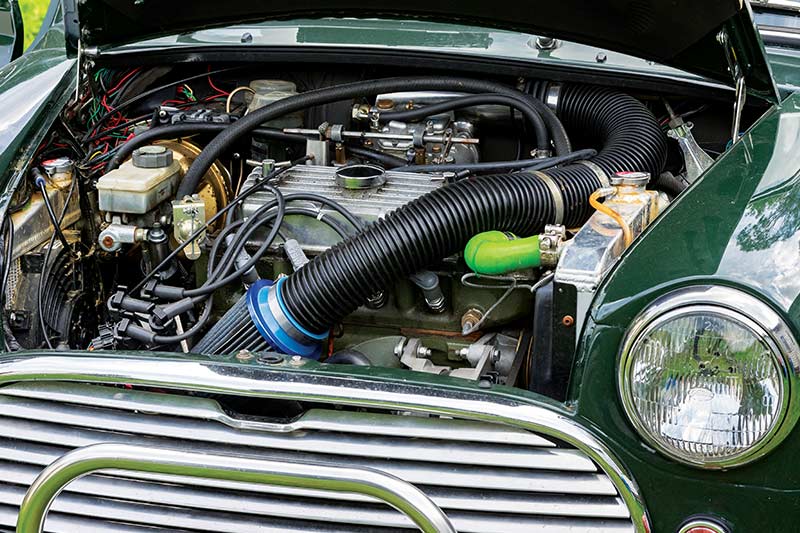 Yes, it would have been easier to just bolt on a turbocharger
Yes, it would have been easier to just bolt on a turbocharger
The driving position is the standard, on-the-drugs Mini layout with a flat wheel an impossible distance away from you, teeny-weeny, offset pedals and a surprising amount of space between you and the windscreen. The standard instrument binnacle has been retained, but there’s now a pair of combined oil-pressure/water-temperature gauges; one for each engine. There’s a single ignition key and in the `on’ position, both ignition systems are live. But you start each engine individually (because one might take more cranking than the other) and to do that, you press down on a small toggle switch beside the steering column and turn the key to the crank position. After a second or two, the rear engine blurts into life and you can release the key. Next, you flip the same toggle switch to the up position and hit the key again to engage the front starter. It fires easily, too, and then you sit back and watch the faces of bystanders who’ve just seen the little green car start up twice.
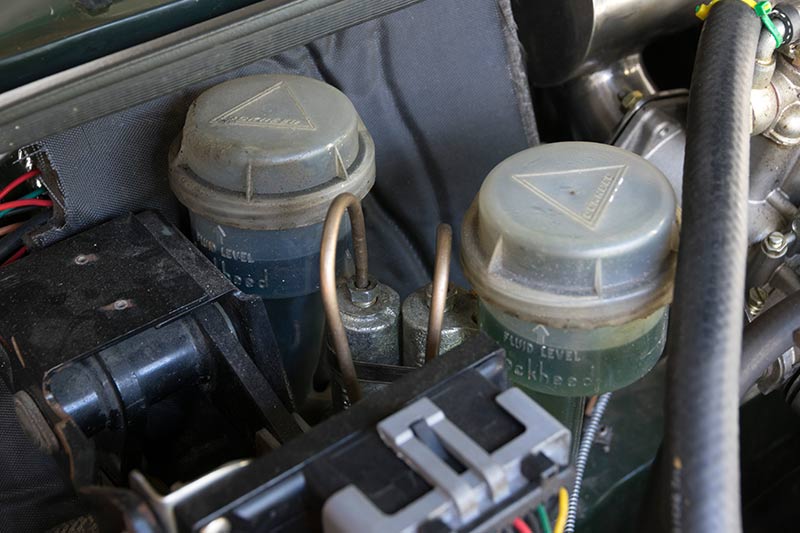
There’s a reason for starting the rear engine first; with twin carbies, it’s the one that is most likely to flood and, since you’re pumping both throttles at once when you’re starting, you’re better off risking flooding the front engine since it’s less likely to happen.
Once both A-Series are up and running, you can give the loud pedal a blip and marvel at the way the car vibrates and makes a racket from both ends. The gearchange is a bit notchy, but no worse than some stock Minis I’ve driven, but that clutch (clutches) is a monster. It’s important to press it all the way to the floor, too, as you’ll graunch the gears if you don’t. Chris reckons he’s biased the clutches a bit so that the front one takes up just a fraction before the rear. I couldn’t pick it, to be honest, but what you will notice is the huge torque this thing generates. Oh, and the noise; yep, this thing is loud.
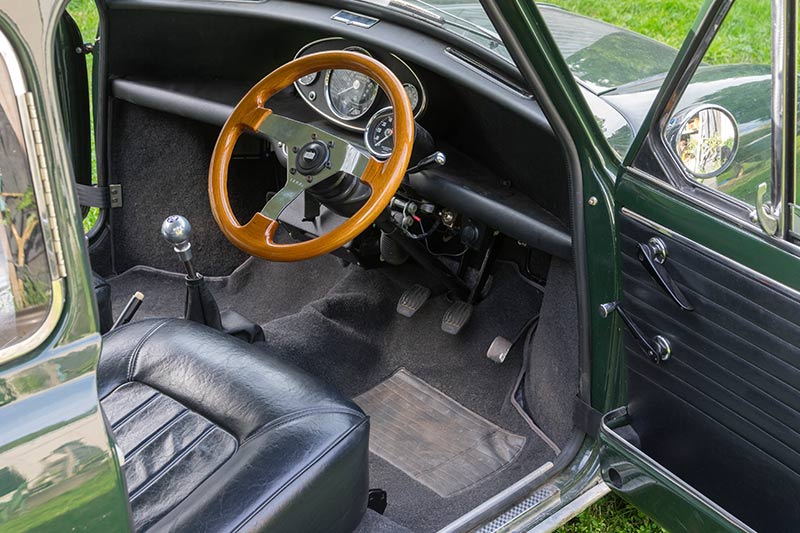
Chris insists on getting some heat into the engines before we let the Mini off the leash, and while I can see his point, it’s certainly not because the engines are fluffy or stutter when they’re cold. Quite the opposite, in fact, and the sorted feel of the Twini is something else. And when it has warmed up and you raise the revs to about 3000rpm in second and hit the noise, the thing takes off like no other bull-nose Mini I’ve ever driven. To be honest, it didn’t feel like it was revving out as cleanly or eagerly as it probably should, but Chris reckons that’s down to the camshafts. Me? I reckon it feels (and smells) more like both engines are jetted a bit fat, and a session on the tuning dyno should sort it.

There were two things I expected from this car that didn’t pan out. One, there were no exhaust harmonics as the two engines ran in and out of synch with each other (if you’ve ever ridden a motorbike behind another motorbike, you’ll know the sensation). Secondly, there was none of the harsh ride that I’ve come to expect from classic Minis. In fact, Chris’ car rides extra well and justifies his decision to stick with the Hydrolastics. And the fact that it’s four-wheel-drive? Obviously there was no wheelspin, but the all-paw layout also seems to have cancelled out the majority of the torque-steer familiar to those who’ve driven a tuned brick. And it’s a simple approach to all-wheel-drive, too: Since each powerplant is an independent, unlinked unit, there’s no need for complexities like a centre diff. In fact, Planet Earth is your centre diff. Brilliant.
 It's a tight squeeze but with the rads up front and a mild easing of the bulkhead it'll go
It's a tight squeeze but with the rads up front and a mild easing of the bulkhead it'll go
DOUBLE TROUBLE
Twin-engined cars have been dabbled with by many manufacturers. Alfa Romeo had tried to break the stranglehold of the Silver Arrows in Grand Prix racing by utilizing two straight-eights in a P3 Grand Prix chassis. The solution was innovative, if not hugely successful. Volkswagen had a famous twin-engined Scirocco, the 1982 BiMotor,and Mercedes built four examples of the A38 AMG, two of which they gave to Mika Hakkinen and David Coulthard. With a 1.9-litre engine up front and one in the boot, the A38 AMG could hit 100km/h in 5.9 seconds.
 It has two engines and still has back seats. Issigonis would have approved of this packaging job
It has two engines and still has back seats. Issigonis would have approved of this packaging job
THE ORIGINAL TWINI
It depends on who you talk to, but it seems likely the first twin-engined Mini was built in Britain by race-car builder Paul Emery back as early as 1962 or 63. Naturally, the factory took an interest and BMC initially developed a Moke with two engines. Inevitably, John Cooper lined up for a play in the BMC Moke and it took about four nano-seconds for him to realise the competition potential of a Mini with twice the horsepower and four-wheel-drive.
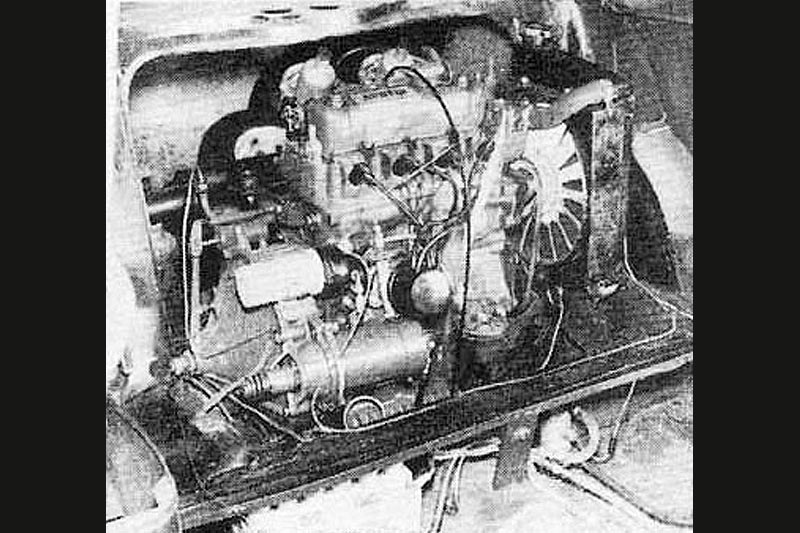
BMC went on to build its own Twinis and even Downton Engineering built one and entered it in the 1963 Targa Florio, although the results never really matched its initial promise. But it’s Cooper’s own Twini that is the best known…for all the wrong reasons. Punting along the Kingston by-pass near his factory in May 1964, Cooper’s Twini left the road and rolled. Cooper suffered life-threatening head injuries but survived.
The car was so badly damaged that it was difficult at the time to say what had gone wrong, but an investigation of the skid marks suggested the rear engine may have seized, sending the car into its death-roll. Now they tell me…
CHRIS' MINI IN DETAIL:

Buy it now
Because everyone needs an eight-cylinder Mini, okay?
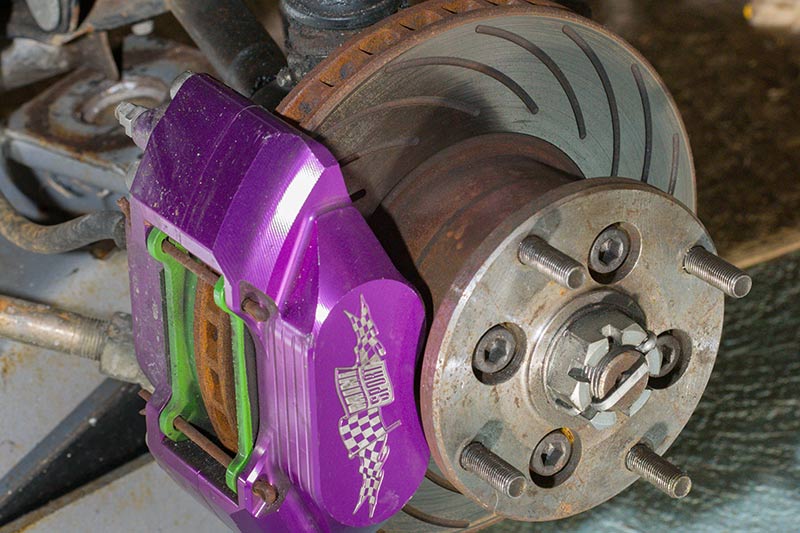
Them's the brakes
Stopping this car is an exercise in packing the most meat into a tiny wheel diameter..
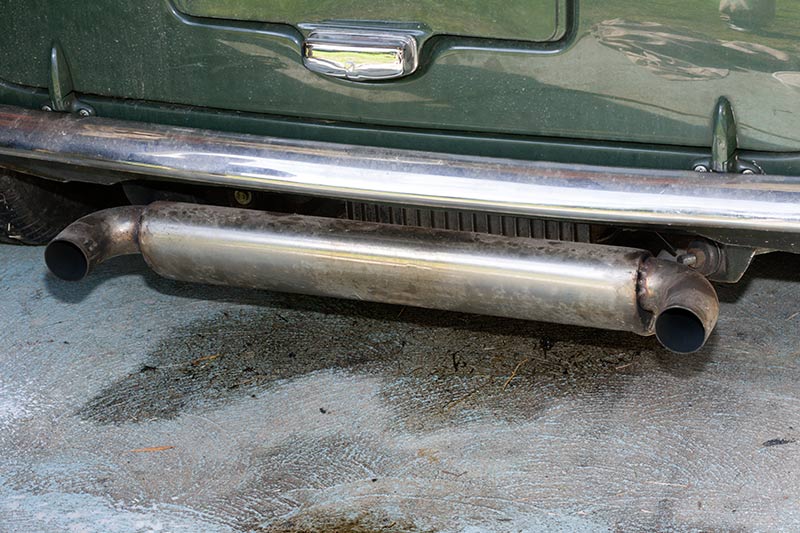
Loud and proud
You’ll hear this thing coming from a way off. The exhaust system must have been a bit of a head scratcher.

Cool runnings
There are two radiators, one for each lump, located either side of the front engine.
VOTE FOR OUR READER RESTO OF THE YEAR
Vote for Chris' Mini in the Unique Cars Reader Resto of the Year and you could win one of five $100 Visa gift cards.
Unique Cars magazine Value Guides
Sell your car for free right here
Get your monthly fix of news, reviews and stories on the greatest cars and minds in the automotive world.
Subscribe


.jpg)










